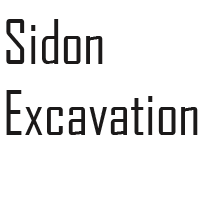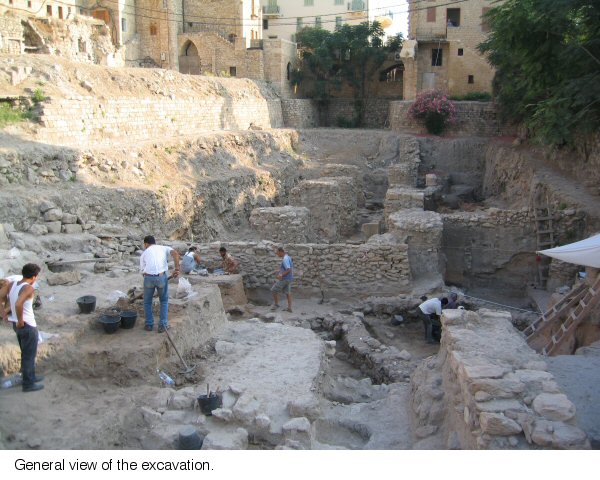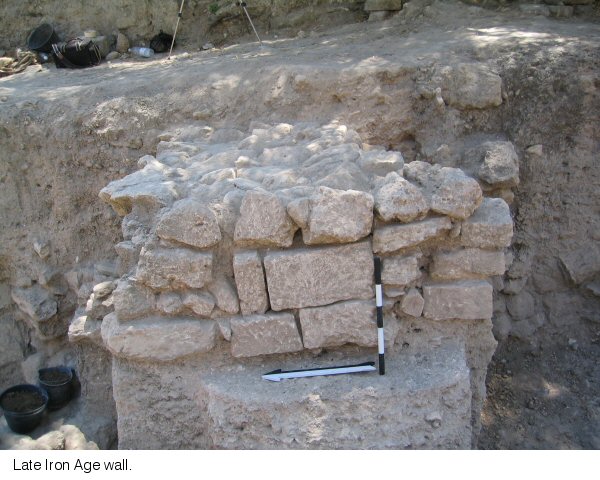YEAR 2005
The seventh season of the British Museum excavations on the mound of the ancient city of Sidon has continued to reveal new and important material about the history of the city and the archaeology of Lebanon. In addition to the British Museum, welcome support was given by the British Academy and private Lebanese individuals and companies.
Our previous excavations of 1998-2004 revealed important historical facts and the seventh 2005 season was no exception. The highlight of the season’s finds in 2005 was a cuneiform tablet, only the second ever to have been discovered in the Lebanon and the first to be associated with one of the major Canaanite/ Phoenician city-states. A faience bowl, an Egyptian import, decorated in black with a frieze of lotus petals was also found, bearing the throne- and birth-names of Queen Tawosret (1188-1186 BC) in ‘cartouches’. This is a rare attestation of the queen outside the borders of Egypt. In addition the 2005 season once again re-established a unique stratigraphical sequence stretching from the third millennium BC to the first millennium BC.
A second Early Bronze Age building consisting of at least 4 rooms was excavated this year. These rooms contained a large amount of pottery, grinding stones and large beams of carbonized wood that had fallen on the floor. Room 1 rectangular in shape, had a doorway 55 cm along its western wall leading to room 4 that will be further excavated in 2006. To the south of room 1, an east west wall was found on the floor indicating an earlier stage to this room with a different wall alignment. This will also be further investigated in the next season. To the south of room 2, there was also another wall on the floor made of small stones randomly coursed indicating once again an earlier use to the building. Room 3 partially excavated will require further investigation.
The Middle Bronze Age
A further ten Middle Bronze Age burials were discovered this year bringing the total of burials to 60 so far. A constructed grave lined with mud brick contained the remains of an individual of approximately 10-15 years old buried with pottery vessels. In addition two silver rings were found on the second and third fingers of the deceased’s left hand with an amethyst scarab held within the palm. Another burial of an 8 to 12 years old individual revealed a Cypriote jug. (Sidon’s contacts with Egypt and with Crete during the 18th century BC have already been underlined in previous reports). One other adult grave was found in addition to six jar burials of neonates and children buried with pottery vessels, beads and scarabs. One burial was a layer of disarticulated remains with around 13 adults and three sub adults lying on the ground. Six scarabs were recovered in this layer with many pots, a bronze pin and a stone bowl.
The remains of a monumental building originally found in the 2000-2001 seasons, were exposed in 2004 and further excavated in 2005. This impressive building has stone walls of excellent quality measuring 1.09 m wide with large boulders on top, reaching 1.22 m in height in the North West corner. The monumental structure and size of this wall (42. 66 m) indicate an important public building which in size is comparable to the Syrian palaces of Ras Shamra. A whole series of thin chalky clay layers (floors) were found in the north-west corner with a large rectangular block of dark clay on the floor of the eastern face of the wall.
The entrance:
The building’s entrance way consisted of a stone floor mainly composed of limestone but with some sandstone blocks of varying sizes. Whilst most of the stones consisted of nodules with a flat side forming the surface, others were roughly hewn into slabs. Three of these, two large round flint stones and a square limestone stone had been placed in a row with equidistant gaps in between. This area may have formed part of a portico with the stones acting as pads for columns. The entrance is intersected from the north east by what may have been a little pathway. The east-to- west cut of a possible beam slot was found in front of the portico. The purpose of this beam in the entrance could be for a threshold or may have had other structural or ornamental purposes. A wall outlined the entrance-way into the building. A more elaborate entrance way with dressed stones is presumed to have been there with two walls on either side. A bench that survived to its original height might have been part of a waiting room in the entrance way.
The bench consisted of random courses of varying sizes of limestone blocks and was bonded to this entrance wall immediately inside the eastern side of the building.
This important building of to the Middle Bronze Age was also used during the Late Bronze Age period. The material uncovered so far contained many oil lamps, a kernos, scarabs, the head of a gold duck and many plates and jugs. The presence of such specific material with very few sherds of cooking pots for example could point toward a more specific use of certain rooms in the building. Further excavations will be needed to clarify these issues.
As well as the remains of a cella or “holy of holies” found below-ground at Sidon which is comparable to Syrian temples namely Alalakh further Late Bronze Age material was uncovered. Two large tannurs were found adjacent to spread of baked mud bricks. The bricks, around 40 in total vary in size and thickness. Large amounts of pottery were found interspersed among the bricks as well as fragments of a faience bowl. This vessel, an Egyptian import, was decorated in black with a frieze of lotus petals. Bearing, in ‘cartouches’, the throne- and birth-names of Queen Tawosret, this is a rare attestation of the queen outside the borders of Egypt. Tawosret ruled independently as the last pharaoh of the 19th Dynasty, around 1188-1186 BC, and used the full titulary of a king.
On one fragment the inscription reads ‘[…], who repels the foreign lands, Sovereign of Upper and Lower Egypt, Lady [i.e. ‘possessor’] of Lands, Lady of Strength’. The adjoining second fragment reads ‘Lady of Action, Satra-Meryt-Amun [lit. ‘Daughter of Ra, Beloved of Amun’], and a third completes this with ‘[Ta]wosret [lit. ‘She of the (goddess) Wosret’], chosen one of [Ra]’. Following this final name is part of the same name but written in reverse orientation, showing that the two halves of the cup were decorated with antithetically arranged inscriptions of parallel content. Above this line of text there are traces of another, much effaced and mostly broken away, but including remnants of the same queen’s cartouches. We owe the reading of these fragments to Marcel Marée, curator at the Department of Ancient Egypt and Sudan at the British Museum.
The Iron Age at Sidon has been excavated since 2003 and was found to be relatively well preserved in one area. Fifth century pits as well as fourth century floors associated with walls were found. No coherent architectural outline could be discerned from the mid-8th century. Instead a series of four plaster floors with a mortar layer underneath were found. Cypriote sherds and one Euboean skyphos of the sub-protogeometric type with pendant semi-circles were found on the floors. In each case every floor level by its very nature had accumulated these remains over a period of time. The assessment however at this stage of the time span between each occupation remains very difficult. Open forms are the most common type of vessel found. The Cypriot pottery points to 9th to 8th century BC. The local pottery shows comparisons to Tyre and Sarepta.
The Sidon excavation stands out as one of the most important archaeological projects in the Lebanon for several reasons:
All stages in the urban development of the city starting from the end of the 4th millennium to the first millennium are present in an uninterrupted stratigraphy. An established typology for the third, the second and the first millennium has not yet been clearly determined for the Lebanon. The two main sources of information remain the soundings at Tyre and the excavations at Sarepta, both dating to before 1974, the date after which the war started in Lebanon. Since then no proper excavations and publications were undertaken.
The volume covering the stratigraphy of Sidon in the third millennium BC 1998 – 2001 seasons is in press.
Sidon is a reference site for the study of the first appearance of Cypriote pottery in the SCIEM 2000 project.
Sidon is also a reference site for a statistical study of the occurrence of Egyptian common ware (with the Tell Daba’a project) on the Levantine coast in the second millennium BC.
The locally made pottery shows the original character and the true pace of the urban development of southern Lebanon. The Minoan, Mycenaean and Euboean imports underline the importance of the sea and the city-state’s Mediterranean contacts throughout its history. The pottery imports provide the evidence that clarifies the nature of these exchanges.
Written records from the city have been found for the first time.
All Cypriote and Mycenaean pottery found since 1998 are being catalogued and will be published in a volume, Ceramics and Terracotta Figurines from Sidon: Mycenaean and Cypriote. This will be the first ever volume on Cypriote and Mycenaean pottery published for the Lebanon.
The area being excavated around 6000 sq m has revealed to date, two buildings from the third millennium BC, one building from the Middle Bronze Age one for the Late Bronze Age. A total of 4 buildings. Two more building which started to appear this year will be excavated in the 2006 season.
Sidon is only the second urban excavation to take place in the Lebanon after Beirut however, it offers much more than the Beirut excavations as work is undertaken on land expropriated by the Lebanese Department of Antiquities for the sole purpose of research. This means that this is a project with no time limit and no pressure from developers.
The continuation of this work is essential because without fail every year has contributed to clarifying matters relating to the typology and the dating of material. Never before has such systematic work been undertaken in the Lebanon and the results will be a hallmark for the understanding of the archaeology of the Levant. Above all, the material found at Sidon attests to affinities and contacts with Palestine and less frequent contacts with Syria, but what is paramount is the city’s emergence as intermediary between these two cultures.








